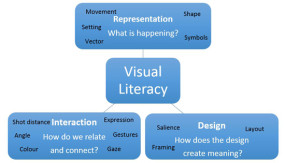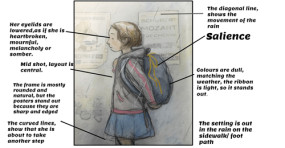- Your School Type
- Solutions
- Resources
- Blog
- Events
- More
- Contact Us
- Book a Demo
- Get a Quote
_-_28de80_-_e4869c155bc9589b39b665136216924a1c47dffd.jpg)
For this guest post (originally published 22 November 2017), we are delighted to welcome K-6 Teacher Librarian Josephine Laretive, from Moriah College, Sydney.
Josephine has been working in the profession since 2002, having previously completed a Graduate Diploma in Information Studies Teacher Librarianship. She is currently updating her studies and completing a Master of Education in Teacher Librarianship at Charles Sturt University.
A passionate Teacher Librarian and researcher, Josephine generously makes her work available in a range of formats, including:
You can find out more about the conference and other featured speakers in this blog post, and on the conference web page here.
In recent years, I’ve planned lesson series for Year 5 with the aim to introduce and explore elements of visual literacy using the Children’s Book Council of Australia (CBCA) Short List Picture Books. This post reflects on the planning process, the requirement to update my own skills, and the need to allow the students to explore, identify and organise ideas in order to demonstrate their learning.
I admit that identifying exactly where visual literacy sits within Australian Curriculum and NSW Syllabus was not straightforward. It became evident that direct reference to visual literacy was limited, it is however embedded within the content of several stages of the English syllabus. In order to plan accordingly and apply the learning to picture books, I found the General Capabilities of Literacy and Critical and Creative Thinking provided a wider scope to base the teaching and learning activities.
In summary, visual literacy or visual grammar provides terminology to help understand and describe features of an image that create visual meaning. We learn who or what is in the picture, the activities involved, interactions between characters, emotions, and how the image catches our attention. As stated in the NSW Education Standards Authority English K-10 Glossary visual language:
Reference to visual knowledge in the Australian Curriculum General Capability Literacy incorporates:
The aspect of the Critical and Creative Thinking General Capability that assisted development of the learning sequence was inquiring – identifying, exploring and organising information and ideas. Specifically, this entails students to “pose questions, identify and clarify information and ideas, and organise and process information” (Australian Curriculum Assessment and Reporting Authority, 2017).
As I started to build my knowledge of visual literacy I contemplated how to provide students with examples and summaries of terminology and allow for opportunities to explore. Books and papers that were of great use are listed in the references, however, I would like to highlight the work of Jon Callow, Lorraine McDonald and Sarah Forrest. From their explanations, summaries and examples I compiled a visual literacy guide to assist students with language and provide examples with picture book images.

In order to deepen my skills I applied the visual literacy terminology to a selection of picture book images.
The CBCA short list picture books provided a wonderful opportunity to connect with a range of quality literature. The books contained insightful social and emotional context and differing styles of illustrations, they proved to be exemplary for exploring visual literacy. Examining images in the picture books also helped to add meaning and build depth to each story. Reading and exploring the short list picture books encourages a wide variety of possibilities to cover a range of English outcomes including engaging personally, developing and applying contextual knowledge, and responding to texts.
As each book was read a feature of visual literacy was presented. As suggested by Forrest (2017), providing such instruction and direction to recognise, discuss and label visual techniques ensures students are introduced to the language of visual literacy. Purposeful selection of a range of visual grammar elements such as the use of colour, salience, gesture, or line, enabled the students to be introduced and revise language used to describe the representation, design and interaction within an image. Additionally, as defined by Pantaleo (2016), as students make meaning of the image elements they also engage in critical thinking skills including reasoning and interpreting.

Text Copyright © Angela May George, 2016. Illustration Copyright © Owen Swan, 2016. First published by Scholastic Australia, 2016. Reprinted by permission of Scholastic Australia.
Once we had completed reading and exploring each book, students worked with a partner and selected one of the books and one image to focus on and annotate. Students referred to the visual literacy guide which provided examples of terminology and direction on how to organise their summaries.
Overall we were highly impressed with the level of student engagement and commitment to learning. Some students selected to take a photo of the image and add annotations using Word inserting callouts, while others were provided with a colour photocopy of the image to annotate by hand. Once complete the students uploaded their work onto the school LMS allowing for sharing and feedback.
Pantaleo (2016), in an observation of teaching and learning visual literacy lessons with primary aged students, suggests focusing on one visual literacy element at a time and having students write a personal response of their learning after reading a picture book. Callow (2016), highlights the many opportunities of the Australian Curriculum to read and engage with books to explore visual literacy. Furthermore, Callow (2016), encourages us to create opportunities for students to investigate picture books to locate visual literacy elements and to allow students to create their own images using visual literacy learning.
Using the CBCA short list picture books allowed for an outstanding series of learning experiences. However, following a few simple steps to introduce visual literacy and providing for students to explore and respond with examples can be adapted to a wide range of purposefully selected picture books. Focusing on one author/illustrator such as Bob Graham, Aaron Blabey, or Emily Gravett and using a selection of their books would allow for successful instruction and exploration in small groups.
Australian Curriculum Assessment and Reporting Authority. (2017). Critical and Creative Thinking. Retrieved from https://www.australiancurriculum.edu.au/f-10-curriculum/general-capabilities/critical-and-creative-thinking/
Australian Curriculum Assessment and Reporting Authority. (2017). Literacy. Retrieved from https://www.australiancurriculum.edu.au/f-10-curriculum/general-capabilities/literacy/
Callow, J. (2016). Viewing and doing visual literacy using picture books. Practical Literacy, 21(1), p.9-12. Retrieved from https://www.alea.edu.au/
Forrest, S. (2017). How does it make me feel? Using visual grammar to interact with picture books. Literacy Learning in the Middle Years, 25(1), p.41-52. Retrieved from https://www.alea.edu.au/
NSW Education Standards Authority. (2017). Glossary. Retrieved from http://syllabus.nesa.nsw.edu.au/english/english-k10/stage-statements/
Pantaleo, S. (2016). Primary students’ understanding and appreciation of the artwork in picturebooks. Journal of Early Childhood Literacy. 16(2), p.228-225. DOI: 10.1177/1468798415569816
Bates, K. (2016). Making interactional meaning in visual narratives more meaningful. Practical Literacy, 21(1), p.21-18. Retrieved from https://www.alea.edu.au/
Barton, G. (2016). Unpacking visual literacy for early learners. Retrieved from https://readingaustralia.com.au/2016/11/unpacking-visual-literacy-for-early-years-learners/
McDonald, L. (2013). A literature companion for teachers. Primary English Teaching Association of Australia (PETAA), Australia.
Editor’s note: This post was originally published November 2017 and has been updated in February 2022 for freshness and accuracy.